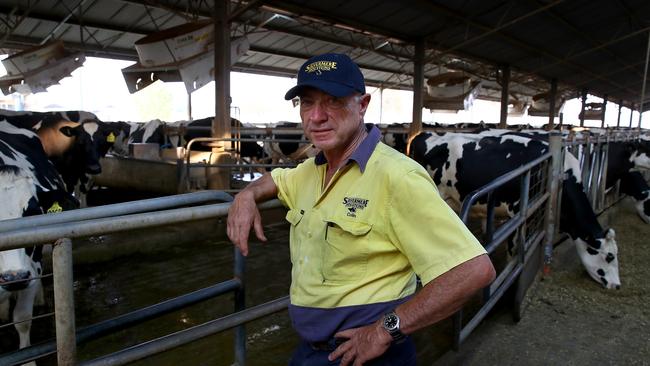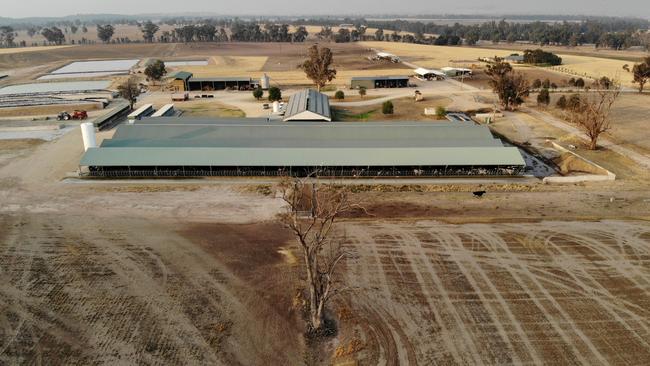Dairy farmers on frontlines as dairy challenges take their toll
Once a backbone industry in NSW, many dairy farms are now on the brink of collapse. As part of a special investigation, The Daily Telegraph’s Tim Blair, Warren Brown and Toby Zerna took a 2000-km road trip to find out what’s ailing the industry. This week we tell you their stories.
NSW
Don't miss out on the headlines from NSW. Followed categories will be added to My News.
- NSW no longer the land of milk and honey
- Coles agrees to pay dairy farmers $5.25m
- Dairy farmers getting milked for all they’re worth
At an abandoned desk in his makeshift farm office, Peter Enever points to a wall calendar permanently stalled on September 2017.
His fingertip leaves an imprint, in cobwebs and dust, on the 26th.
That was the day, following decades of hard work, Enever finally quit being a dairy farmer.
The veteran Wagga Wagga farmer came to that decision after checking his accounts, factoring in rising dairy production costs and balancing those against declining profits. Then he added in a variable: some farmer’s intuition about what the future may hold.
Sadly, none of Enever’s calculations, nor his cattle clairvoyance, gave him any faith to continue. In fact, he says, if he’d persisted with his dairy he’d “have gone through profits and begun going into debt”.

Enever is a resourceful man, as you’ll soon discover, and he quickly put his farm to other uses. But as far as the dairy experience goes, his is an outcome occurring often locally and throughout rural and regional NSW.
Only a decade or two ago, the region around Wagga Wagga was able to support around 20 dairy farms. Now only a few remain. Further south, in Deniliquin, 40 dairy farms have now been cut to single figures.
Likewise, there were more than 1700 dairy farms across NSW in 2000. By 2015, even before Enever quit the dairy caper, that number had fallen to barely 700.
During the next five days, The Daily Telegraph will bring you the results of a comprehensive 2000-kilometre road trip investigation of the dairy industry in our state, covering everything from supermarket price pressures and the drought to huge blow-outs in food costs and the rising menace of farm invasions.
As well, our three-member investigative team will detail the impressive success stories emerging from an industry under extreme pressure, and celebrate the farming families that are sticking together through the tough times to keep their businesses alive and viable.

You will also learn something of the affection dairy farmers have for their livestock, and the care taken (and capital invested) to keep every cow content and productive.
Unhappy cows, you see, do not supply much milk. It is very much in the interest of dairy farms to treat their cows kindly.
Colin Thompson, owner and operator of Cowra’s Silvermere Holsteins, estimates he loads around 60 tonnes of sand every week into his Holsteins’ stalls – just so they have a nice place to rest.
“You want them to be laying down for about 12 hours per day,” Thompson explains, “because that’s when they’re making milk.”
With soft sand below and cooling fans above, Thompson’s Holsteins are happy to the tune of 44 litres of milk per cow per day.


Drought, market fluctuations and high running costs are perennial challenges for all Australian farmers, but some in the NSW dairy sector face difficulties no reasonable person could possibly have foreseen.
Due to European Union rules that protect historic and geographic food identification, for example, Australian cheese producers like Erica and Nic Dibden may shortly be banned from using traditional names such as parmesan, camembert, brie or gorgonzola.
Not that it should make much difference, at least in the Dibdens’ case. We’ve tasted the prize-winning brie at their Tilba Real Dairy in Central Tilba, and it would be just as delicious and just as popular if it was called Old McCurdey’s Solid Milk-Based Fungus Chunks.

As for Peter Enever, he rebounded quickly from that decision to shut down his long-running dairy operation. During the following year, in 2018, he instead ran 100 head of young Angus steers on his farm.
Compared to the tough daily work of a dairy farmer, this was remarkably easy. Enever simply waited for the beasts to fatten from 250 kilograms to 400 kilograms or so and then sent them away for sale at feedlots.
“I made more money doing that in 12 months than I did in the last 12 months of running the dairy,” Enever reports.
“And I did nothing.”
For others working in dairy, things have not turned out so well. Others still are finding ways forward. This week we tell you their stories.
